
Users of mobile electronic devices such as cellphones (and other wireless devices) are exposed to radio frequency (RF) radiation. The amount of RF exposure absorbed by a body is measured by the specific absorption rate (SAR), which represents the RF energy rate. To help design safer devices, engineers can compute local SAR values of a human head model as it absorbs a wave from an antenna using the COMSOL Multiphysics® software.
Using SAR to Measure RF Absorption Rates
When we use wireless devices, our bodies are exposed to RF energy from an antenna that is attached to the respective device. Therefore, it is important to understand the health implications caused by electromagnetic (EM) exposure. The RF energy from the antenna propagates through tissue and becomes dissipated as heat, which our body is able to absorb. The amount of RF energy absorbed varies with the frequency of the RF signal.
When engineers prototype devices that emit RF energy, they design them with characteristics to fit within safety guidelines. This is to ensure that they do not exceed the maximum exposure levels. In order to see if these devices are safe to use, we can measure the amount of RF exposure given off by SAR testing. The SAR test provides appropriate characteristics for determining the maximum EM exposure in various devices. It is calculated by using:
where σ is the electric conductivity of material, |E| is the norm of the electric field (RMS), and ρ is the mass density. The value is measured in watts per kilogram (W/kg).
Using COMSOL Multiphysics and the RF Module, we can compute and analyze the local SAR values over a simplified human head and brain when next to an operating microstrip patch antenna in the Wi-Fi frequency range. This model shows how a human head absorbs a wave from an antenna under RF emission.
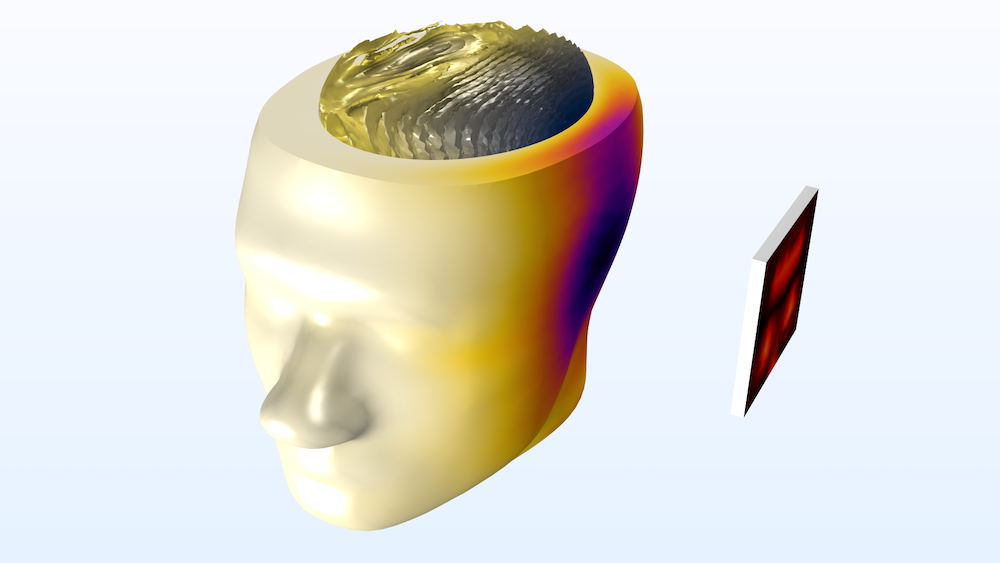
SAR plot of a human head inside an approximate model of brain tissue and the electric field norm of a patch antenna.
Simulating a Human Head Phantom Under RF Emission
This tutorial model uses an imported human head geometry that is the same as the specific anthropomorphic mannequin (SAM) phantom provided by IEEE, IEC, and CENELEC from their standard specification of SAR value measurements. After importing the geometry into COMSOL Multiphysics, minor adjustments are made and the original geometry is scaled down by 60% to reduce the problem size. Using an ellipsoid geometry, we are able to form a simplified shape of the brain and also characterize parts of the human head using the properties of cortical bone tissue.
The antenna next to the human head is composed of a thin layer of metal, a rectangular FR4 dielectric board, and a ground plane. In the Electromagnetic Waves, Frequency Domain interface, we can represent the metal parts of the antenna (microstrip feed line, antenna radiator, and ground plane) as Perfect Electric Conductor (PEC) surfaces when loss is negligible. A Lumped Port boundary condition (a simplified Port boundary condition) is added to represent a feed from the power source. In this case, the antenna is fed by a 50-Ω lumped port.
To mimic the antenna testing in infinite free space, we enclose the human head phantom and antenna in a spherical air domain by using a Perfectly Matched Layer (PML). A PML works like an anechoic chamber by absorbing all outgoing wave energy and preventing unwanted reflection.
Human head phantom and microstrip patch antenna resonant around the Wi-Fi frequency range. The highlighted part is the PML and a half is removed from the view to show the interior.
Lastly, to calculate the SAR value, a Specific Absorption Rate domain condition is added to the head geometry. The RF energy rate absorbed by tissue is represented by the SAR value (directly available as a predefined postprocessing variable as of version 5.5) and is calculated from the electromagnetic dissipation density and the specified density for the human head.
Note that this model assumes that all materials are homogeneous. For a more realistic brain material characterization, see the Specific Absorption Rate (SAR) in the Human Brain model, where the material parameters, based on the imported MRI image data with volumetric function, characterize the variation of tissue type inside the head.
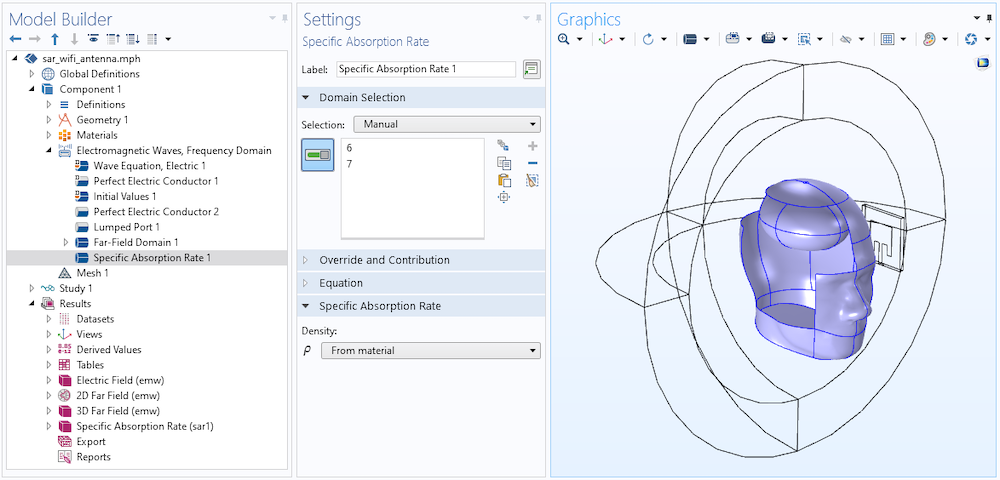
The selected domains for the Specific Absorption Rate feature.
Analyzing RF Effects and SAR of a Human Head
The results below show the SAR value of the human head next to the Wi-Fi antenna. The highest SAR value of the model is the surface area that is facing the incident electric field. Typically, the effect of SAR depends on the antenna position and dielectric properties. The human body contains different values of dielectric properties (permittivity and conductivity) that are functions of variables such as the frequency and geometry. The conductivity and permittivity of human tissues are both factors for RF communication and absorbed radiation. The SAR value increases when there is an increase of resistive loss.

SAR volume at a frequency of 2.45 GHz.
We often think of an electrical signal as a one-way phenomenon, traveling from one source to another. But with RF, electrical signals can travel in both directions due to reflection (similar to how light is reflected by a mirror). The results below show the radiated field from the microstrip patch antenna that is distorted due to the reflection from the human head and the far-field results include those effects.
The distorted 2D far-field radiation pattern on the xy-plane (left) and 3D far-field radiation pattern of the microstrip patch antenna (right) at 2.45 GHz. In order to show the radiation pattern with the head and antenna geometry, the visualization scale and location have been modified in the above plot.
The SAR value is of specific interest to designers and is readily obtained using COMSOL Multiphysics. After simulation, the SAR can also be evaluated on/in an arbitrary shape of a user-defined location (curved surface or volume). When designing electronic mobile devices, it is important to quantify the amount of radiation that can be absorbed by the human body. Using COMSOL Multiphysics and the RF Module allows for a faster and more cost-efficient approach when designing devices to fit within safety guidelines.
Next Step
Click the button below to try the SAR of a Human Head Next to a Wi-Fi Antenna model for yourself. This will take you to the Application Gallery, which includes step-by-step documentation and a MPH file.


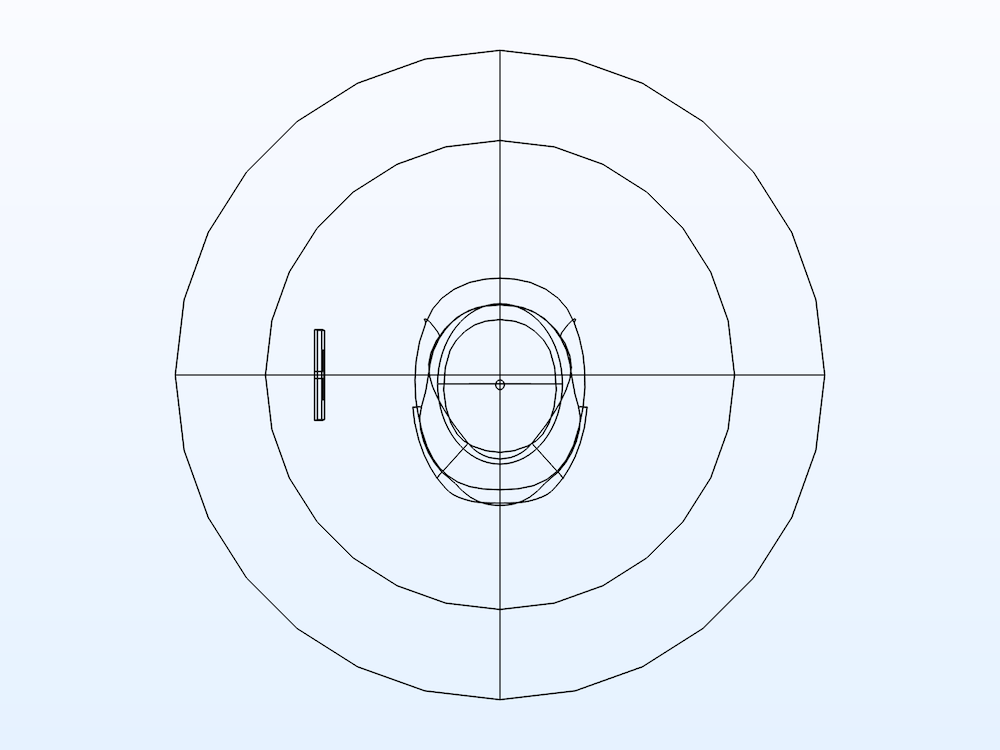

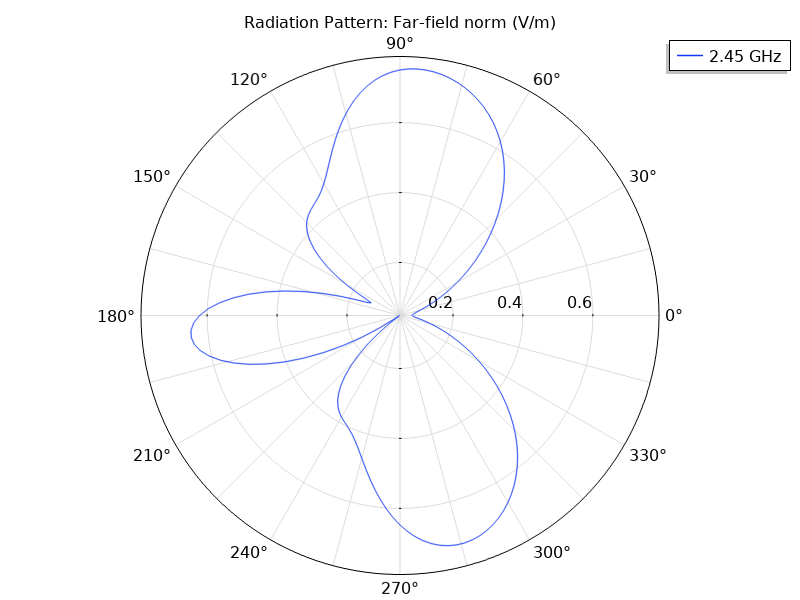
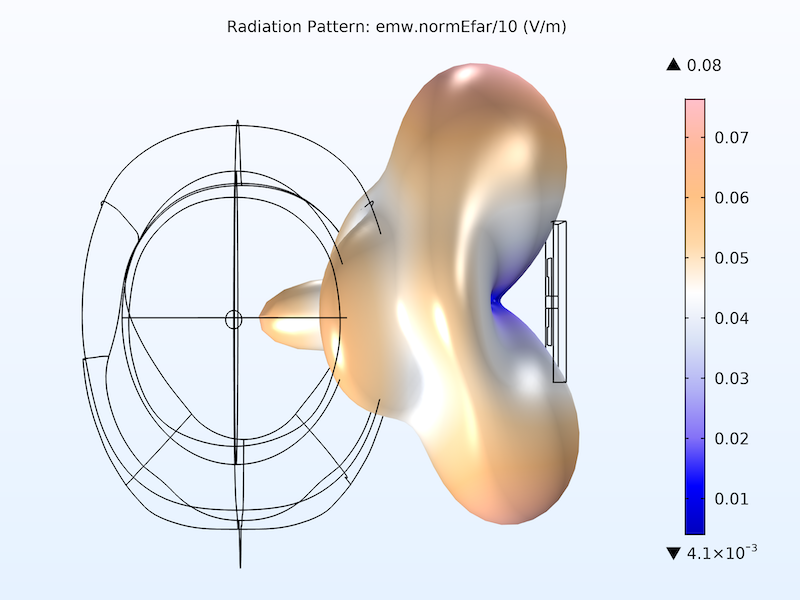


Comments (1)
昊 吴
October 19, 2021Thank you for this classification!